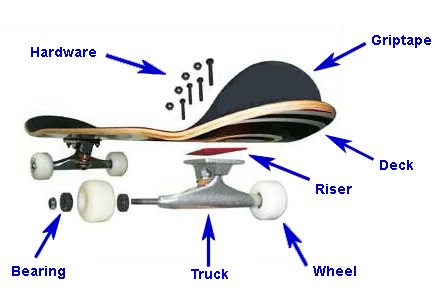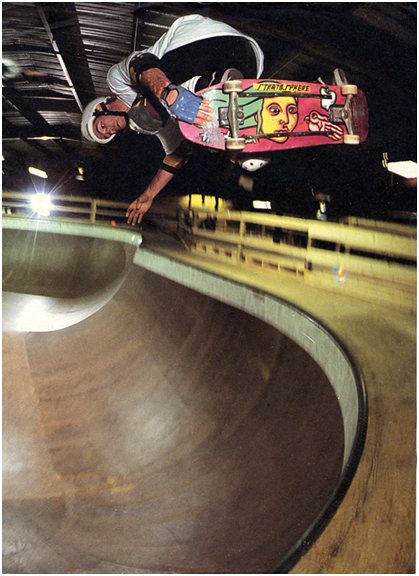Skateboarding in New Media
Nicholas Rollins
Nicholas Rollins
Skateboarding has been a craze since 1958. It was invented by some creative kids who decided to add roller-skate wheels to a mil k crate. Skateboarding has evolved incredibly since then, making the skateboard more practical for the skateboarder as new stunts develop. Skateboarding is similar to new media in a sense, just as new technologies are being invented to make lives easier, skateboard designers create new products and mercha ndise in order to benefit the skateboarding society.
There are four main parts to a skateboard that makes it fully functional. First, we have the deck. A skateboard deck is made from plywood and combined with a polyurethane coating used to make the board slide easier while grinding and gives it a stronger durability. Second, we have the trucks. The trucks are metal and attached to the bottom of the deck. On the trucks, there are bushings which make the trucks movable. There is also an axel which is intende d for the wheels. Wheels are usually made from polyurethane, and come in many different sizes. Each wheel is mounted onto the axel with two bearings. Bea rings are graded according to the ABEC scale. The lower the scale, the slower you will go. The first skateboard that was invented was made in 1958 by att aching wheels from a roller-skate and attaching them to a milk crate. Surfing was popular at this time and this was a way for surfers to surf when there were no waves. It became known as "sidewalk surfing." Within the next year, skateboards were mass produced with metal wheels. As time progressed, newer u pgrades were invented for this new sport to make skating more easier and more fit for the new styles and techniques that were invented.

Surfboard companies such as Makaha and Hobie started making higher quality skateboards in 1963. Trucks were introduced, which we still use to this day . Trucks are one of the most beneficial inventions for a skateboard. Trucks control how you move and turn, giving the skateboarder balance. Clay wheels w ere also released, which took the place of the metal wheels. Riding became a lot smoother and easier. Skateboarding was making a huge impact on society. Newer products were being released, making skateboarding more easier and practical for how the user was skating. 1973 was the turning point for skateboar ds. Urethane wheels were invented making new possibilities emerge. The old bumpy and loud wheels were now smooth and silent. Skaters could skate anywhere possible, it seemed. You could ride in ditches and in banks because the wheels would now grasp the pavement. Skaters were inspired from this new radical form of skating. Shorter boards were designed, giving the skater the ability to have more fluent moves. Surf shops were experimenting, trying to release the best form of a deck by using materials such as fiberglass and aluminum. From this point on, skating would never be the same. Skateboarding was known world-wide and the first skate video, Spinnin' Wheels, was released. Just like a computer program, you need to tweak the versions multiple times until yo u get it just right; however there is never a perfect design. Technologies are always improving to fit the user better, such as creating a new skateboard to preform new tricks that are invented.
A few years later, Skateboarders discovered new spots to skate as newer possibilities came into play. The California drought forced landowners to drai n their pools, giving skateboarders the advantage to skate the empty pools. With the new urethane released, this gave the skateboarder the advantage to c limb the walls of the drained pools. Skateboarders also realized that you can grind using the trucks against the top of the pool while going fast enough to slide. New tricks were invented daily, aerials, inverts, and the Ollie. Concrete parks were being built and professional skateboarders were being made known.
The skateboard slowly turned into the deck we see today, newer techniques became possible. "Once a skater, always a skater," (Jim Murphy, 1980) Jim be came a widely known skateboarder in the 1980s. Now that the deck had a tail and a nose, the skater could Ollie much easier, and also giving the skater th e ability to freely spin the board in many different directions. Street skating turned handrails and walls into free skate parks. Skating now appeared in commercials for a wide variety of products. Everything from soft drinks to phone ads portrayed skateboarding. Fashion trends began to reflect the influen ces of the skating crowd. When Nike acquired skateboard equipment marketer Hurley International for $95 million in 2002, it was another inroad to the cov eted youth market. Nike had initially drawn a snub from 9-to-21-year-old skateboarders for its skateboard shoes. Nike, being Nike, went back and redesign ed the shoe, adding thicker tongues and a different insole from famed sneaker designer Marcus Taut. (Rich Thomaselli, 2004) With new technologies and mer chandise advertising, more people became a part of the skateboarding society.

All of this information relates to new media for many different reasons. Skateboarding can be thought of like a computer. It was invented and tweaked. It went through an evolution process. It started out being made for pure entertainment, and then morphed into a completely different tool all together. P eople today who skateboard professionally get paid millions of dollars to perform in contests and other activities, the same way that computer engineers get paid millions of dollars for new applications and software. There is an entire culture that was made from skating, and these people are creating new things every day to make the skateboarding community well off.